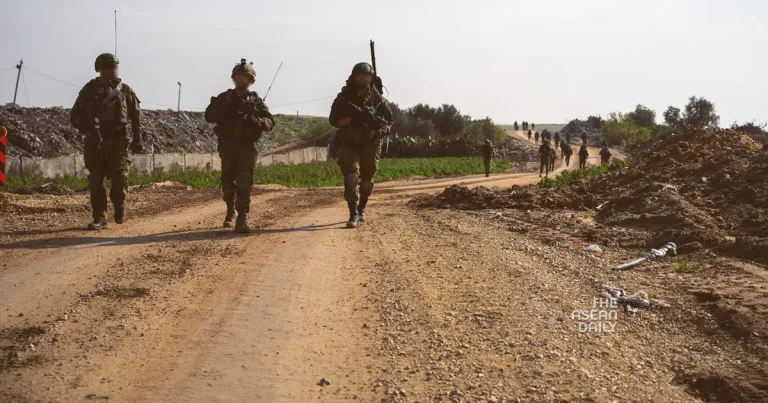16-12-2023 (JERUSALEM) In the ongoing conflict between the Israeli army and Hamas in Gaza, the Israeli military’s casualty count has reached almost double that of the 2014 ground offensive. The surge in casualties reflects the extensive Israeli push into the enclave, coupled with the use of guerrilla tactics and an expanded arsenal by Hamas.
Military experts in Israel, a high-ranking Israeli commander, and a Hamas source have shed light on how Hamas has effectively utilized a substantial weapons stockpile, intricate knowledge of the terrain, and an extensive tunnel network to transform Gaza’s streets into a perilous labyrinth.
Armed with a variety of weapons, ranging from grenade-equipped drones to potent twin-charged anti-tank weapons, Hamas has posed a formidable challenge to the Israeli forces. Official Israeli figures indicate that since the commencement of the ground campaign in late October, approximately 110 Israeli soldiers have lost their lives. This contrasts sharply with the 2014 conflict, which saw 66 Israeli casualties during a more limited three-week ground incursion whose objective was not the elimination of Hamas.
Retired Israeli Major-General Yaacov Amidror, now associated with the Jewish Institute for National Security of America (JINSA), highlighted the unprecedented scope of the current conflict. He emphasized that the army has yet to find an effective solution to the significantly expanded tunnel network developed by Hamas over the past decade.
The Israeli offensive was launched in response to a Hamas-led rampage on October 7, resulting in the deaths of 1,200 people and the abduction of over 200, some of whom have been subsequently released. The toll in Gaza has been devastating, with close to 19,000 casualties, prompting international calls for a ceasefire and even suggestions from the United States, a staunch ally of Israel, for a strategic shift towards more precise strikes.
Prime Minister Benjamin Netanyahu asserted on Thursday that Israel would continue the war “until absolute victory,” with officials acknowledging that it might take months to achieve this goal.
Intense Combat and Evolving Tactics
Hamas, through its Telegram channel, has been sharing videos this month illustrating fighters equipped with bodycams navigating through buildings to launch shoulder-held rockets at armoured vehicles. These videos, however, could not be independently verified by Reuters.
A Hamas source within Gaza, speaking anonymously to Reuters, described how fighters strategically approached Israeli forces, taking advantage of their extensive knowledge of the terrain. He acknowledged the power disparity but emphasized the effectiveness of their tactics.
Hamas has not disclosed the number of its fighters killed, while Israel’s military claims to have eliminated at least 7,000. The group dismisses the Israeli figures, contending that they include civilians.
An Israeli commander, who participated in the 2014 conflict, noted that the expanded scope of the current operation meant more troops on the ground, providing Hamas with the advantages of a defender. The commander, requesting anonymity as an active reservist, attributed the higher troop casualties to this dynamic.
The Israeli military has refrained from disclosing the number of troops involved or other operational details. Israel’s Channel 12 television has featured footage of army reservists cautiously breaching walls to avoid booby-trapped doors and uncover munitions caches.
Building Up Forces and Evolving Weapons
Hamas, since 2014, has made significant strides in building up its forces, acquiring advanced arms such as Russian-designed Kornet anti-tank missiles with the support of its ally Iran. Additionally, the group has mastered the production of weapons in Gaza, including RPG-7 rocket-propelled grenades, contributing to an expanded munitions reserve.
Former Israeli intelligence official Eyal Pinko highlighted the presence of “tandem” anti-tank weapons with two charges in the militants’ arsenal, emphasizing the group’s evolving capabilities.
While videos released by Hamas showcase substantial blasts upon hitting vehicles, Israeli military experts caution that such explosions may not necessarily indicate the destruction of the vehicle. Defensive systems exploding to intercept incoming projectiles could also cause similar effects.
Urban Warfare Challenges for Militants
Despite the formidable tactics employed by Hamas, urban warfare has become more challenging for the militants. Israel’s military has utilized tactics from 2014, including the creation of routes through built-up areas by bulldozers to avoid mined roads. The effectiveness of Hamas’ surprise attacks, even in urban areas, has been eroded by Israeli drones and other countermeasures.
A video posted by Israel’s military this month purportedly shows militants emerging from a tunnel under a bombed building before both are struck by missiles. While Hamas showcases new weapons and tactics, analysts, including former Israeli military intelligence officer Alexander Grinberg, emphasize that, in principle, Hamas remains a guerrilla resistance movement.




